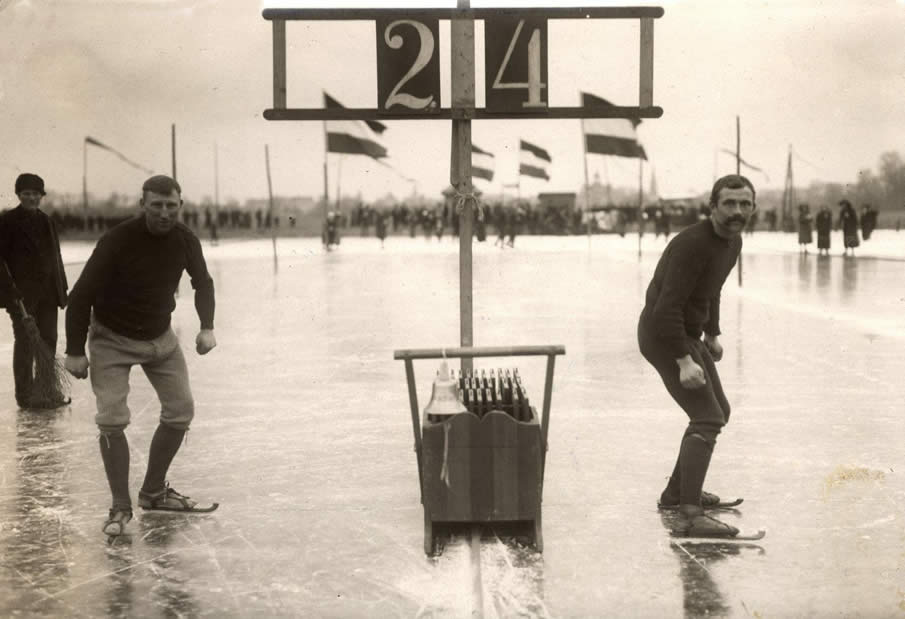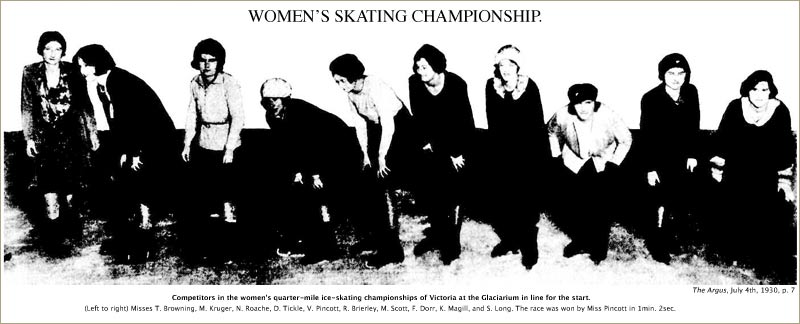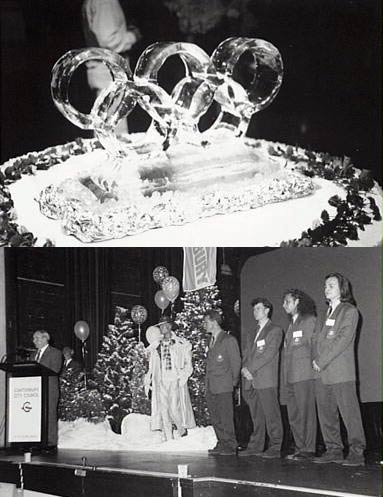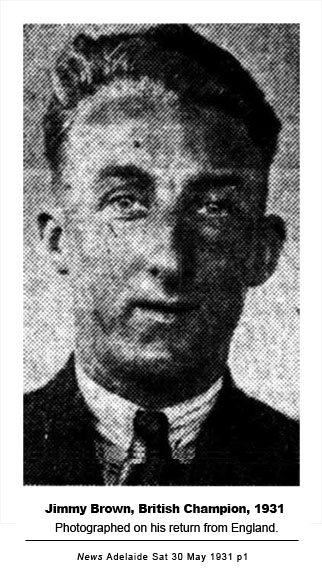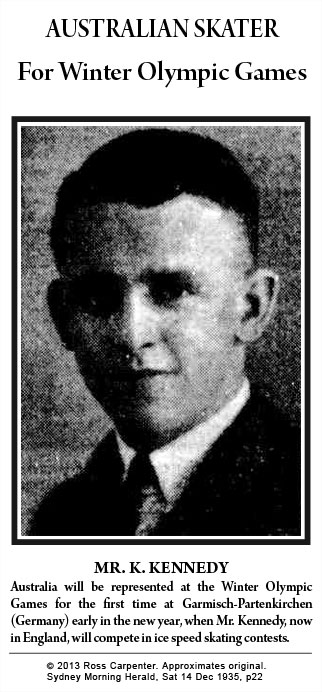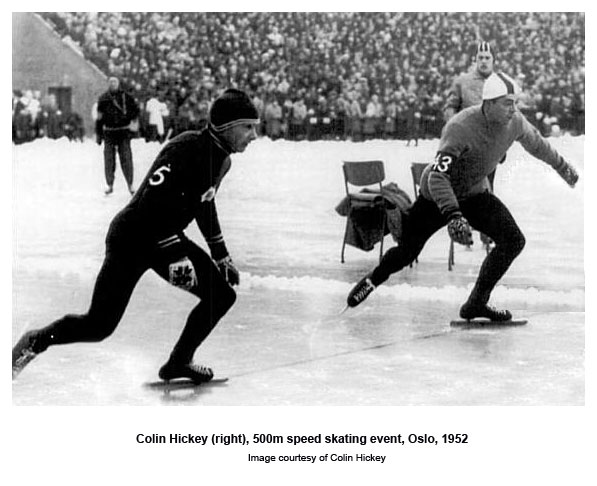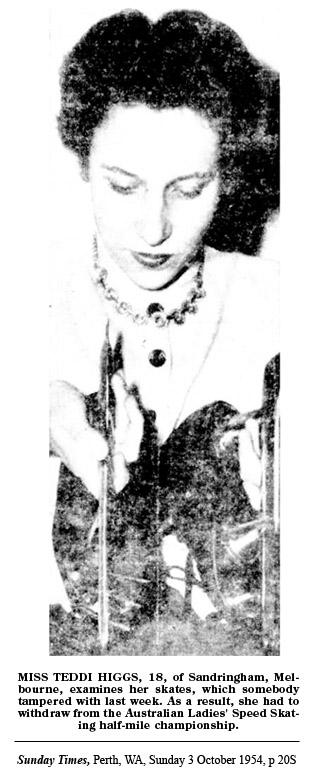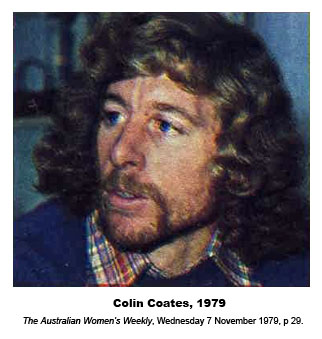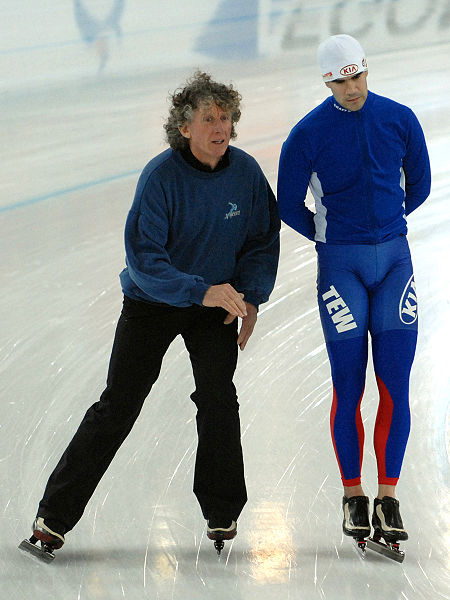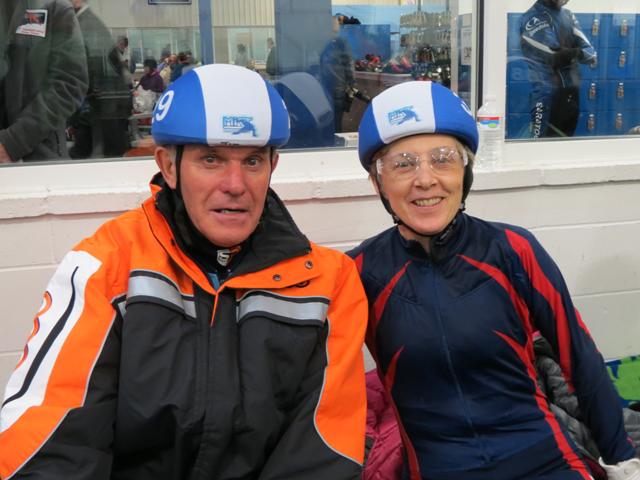Legends
home
1923 Ice Hockey and SPEED SKATING Council of Australia
1929-30 1st Australian SPEED SKATING International
1932 Brown Trophy for Interstate SPEED SKATING
1936 1st Australian WINTER OLYMPIAN and Olympic Speed Skater
1948 Melbourne Amateur SPEED SKATING Club
1949 SOUTHERN FLYERS Speed Skating Club
1949 Les 'Snowy' REID Memorial Trophy (NSWIHA)
1951 Victorian + NSW SPEED SKATING Unions
1952 AAIRC Trophy INTERSTAE RACING (The Duke Trophy)
1957 AAIRC AFFILIATION with International Skating Union
1960s AAIRC TEDDI JENKINS Trophy (Ladies Relay)
2002 AAIRC SPIRIT of the Duke Trophy
The First Ice Racing Champions
1914 on
 ENRY NEWMAN REID, JOHN CALDWELL and Professor Brewer, of Prince's Skating Rink in London, introduced the first forerunners of modern speed skating to Australia. It was in Adelaide in April 1905 that Reid organised the first ice sports competitions in Australia, chiefly comprised of ice races contested in multiple heats. His three sons, Andy, Hal and Leslie, were already proficient skaters, and among the winners of these very first events (see Figures). [330] Professor John Charles Gerald Caldwell, "the Champion Roller Skater of Australia", had been associated with roller racing for two decades, and, like many professional ice skaters of his era, Professor Brewer was also an accomplished speed skater who could skate six laps of the Adelaide rink (500m) in 1 min 2 sec. However, as early as the late-1880s, American Pacific Coast roller champions, such as A N Ridgely and Robert Aginton, had established roller rinks in Australia (see Robert Jackson). Half- and one-mile speed races had been common in their rinks for decades, and similar races were held on ice in Adelaide soon after the ice rink first opened. Some of the crew of the visiting Austrian cruiser SMS Panther raced on Adelaide's ice, and races such as this in 1905 were among the earliest forerunners of organised speed skating in Australia. [335] By June that year when SMS Panther arrived, the Half-mile Scratch had been established; by July, the Half-mile Handicap of Australia; and by August, the Half-mile Blue Riband Handicap. Ice racing then became a regular feature of the sports carnivals organised by the rinks in both Melbourne and Sydney, since their inception in 1906 and 1907, respectively, under the direction of Brewer and Claude Langley in Melbourne, and Dunbar Poole in Sydney.
ENRY NEWMAN REID, JOHN CALDWELL and Professor Brewer, of Prince's Skating Rink in London, introduced the first forerunners of modern speed skating to Australia. It was in Adelaide in April 1905 that Reid organised the first ice sports competitions in Australia, chiefly comprised of ice races contested in multiple heats. His three sons, Andy, Hal and Leslie, were already proficient skaters, and among the winners of these very first events (see Figures). [330] Professor John Charles Gerald Caldwell, "the Champion Roller Skater of Australia", had been associated with roller racing for two decades, and, like many professional ice skaters of his era, Professor Brewer was also an accomplished speed skater who could skate six laps of the Adelaide rink (500m) in 1 min 2 sec. However, as early as the late-1880s, American Pacific Coast roller champions, such as A N Ridgely and Robert Aginton, had established roller rinks in Australia (see Robert Jackson). Half- and one-mile speed races had been common in their rinks for decades, and similar races were held on ice in Adelaide soon after the ice rink first opened. Some of the crew of the visiting Austrian cruiser SMS Panther raced on Adelaide's ice, and races such as this in 1905 were among the earliest forerunners of organised speed skating in Australia. [335] By June that year when SMS Panther arrived, the Half-mile Scratch had been established; by July, the Half-mile Handicap of Australia; and by August, the Half-mile Blue Riband Handicap. Ice racing then became a regular feature of the sports carnivals organised by the rinks in both Melbourne and Sydney, since their inception in 1906 and 1907, respectively, under the direction of Brewer and Claude Langley in Melbourne, and Dunbar Poole in Sydney.
Competitive racing is known to have been held in Holland as early as 1676. Canada’s first recorded race was in 1854 on the St Lawrence river when three British army officers raced from Montréal to Québec City. The Amateur Skating Association of Canada (ASAC), the country's first sport association, was formed in 1887. The International Skating Union had held Long Track ice racing events since its inception five years later in 1892 and the ASAC became the first non-European body to join in 1894. Three countries — Norway, Germany and Canada — contested the 1897 World Speed Skating Championship in Montréal with the world title going to Winnipegger Jack McCulloch. The ASAC was renamed the Canadian Amateur Speed Skating Association in 1960, then Speed Skating Canada in 2000.
It was not until 1914 that World figure skating was first recognised as a separate sport, distinct from speed skating, by a separate Figure Skating Department of the ASAC. Minto Skating Club (MSC) in Ottawa, Canada, was a founding member. This club had been established in 1904, the year Reid's experimental rink opened in Adelaide, and Dunbar Poole was its second figure skating coach during the Australian off-seasons. Poole's appointment at Minto occurred sometime after the club's first professional coach was engaged from Europe in 1911. He left Australia for Canada after the 1921 season in Australia, and it is most probable this was the commencement of his time at Minto. At the 1914 Olympic Congress, delegates agreed to include speed skating in the 1916 Summer Olympics, after figure skating had featured in the 1908 Olympics. However, the First World War put an end to these plans, and it was not until the winter sports week in Chamounix, France, in 1924 that speed skating reached the Olympic programme (awarded retrospectively). The results were cabled to Melbourne:
SPORTING CABLES. SKATING AT CHAMOUNIX. (Reuter.) LONDON, Jan. 27. At the winter sports at Chamounix France the 1,500 metres speed skating Olympiad contest resulted in a win for Thunberg (Finland) in 2.20 4-5. Larsen (Norway) was second, time 2.22. The 10,000 metres race resulted as follows, — Skutnabb (Finland) (18.0), 1; Thunborg (Finland) (18.7 4-5), 2. Four Norwegians followed. The general classification in the four speed skating events placed Thunberg first, Larsen (Norway) second, and Skutnabb third. The classification by nation gives Finland 48 1/2 points Norway 39, and the United States 11. (The Argus, Tue 29 Jan 1924, p 14). Ladies participated at the Lake Placid 1932 Olympic Winter Games in demonstration events and then competed in full medal events at the Squaw Valley 1960 Olympic Winter Games.
The first Australian quarter- and half-mile speed skating races on record for both men and women were advertised in the Sydney Morning Herald on July 21st, 1914, the same year International speed skating was officially separated from figure skating. [2] The first Interstate speed skating competition on record in Australia was held in Melbourne in 1922 for both men and women. [128] Australian speed skating was officially brought under the control of both State and National ice hockey associations in 1923; the year the the Ice Hockey and Speed Skating Council of Australia (IHSSCA) was formed in Sydney, jointly by the Victorian Ice Hockey Association and the New South Wales Ice Hockey and Speed Skating Council. The IHSSCA was the national forerunner to both Ice Hockey Australia and the Australian Amateur Ice Racing Council (AAIRC). Leslie Reid, the youngest son of Henry Newman Reid, and John Goodall, the first IHSSCA president, were largely responsible for its foundation, and they were therefore also the founders of organised Interstate ice racing in Australia.
The decade commencing in 1922 was the golden age of speed in Australian ice hockey, a direct result of the federation of both sports under a unified controlling authority, and the forward-passing, off-side style of the Australian game. The emphasis in Europe and North America during this period was stickhandling, not speed (see Ted Molony). Amazingly, the time required to cover the men's half-mile had halved towards the end of the decade, and the most notable skaters to emerge from it were Australia's first International speed skating champion, Jimmy Brown, and Ken Kennedy, Australia's first Winter Olympian. Both were from New South Wales, and Jim Kendall was largely responsible for their development. Interstate ice racing between New South Wales and Victoria continued for many years as part of the annual Goodall Cup and Gower Cup (women's) interstate ice hockey series. The first ice racing associations independent of ice hockey in Australia were established in the late-1940s. Official records of the winners of National championships prior to then do not appear to have survived, although results were recorded, and some have been published in Melbourne newspapers (also see Women's Ice Hockey and Men's Ice Hockey). It is likely that Leslie Reid was a champion speed skater in Melbourne before the First World War, in the years before unified National titles. Reid turned 18 years of age in 1912 and he was still competitive a decade later in his late twenties, when he was runner-up in the 1922 Nationals representing New South Wales. [128] He had moved to Sydney soon after his return from the war, when ice hockey resumed there in 1920, followed the year after by the resumption of Interstate ice hockey and speed skating.
The first Australian men's half-mile championship on record was held in Melbourne in 1922, and it was won by the captain of South Sydney IHC, Tommy Gibson (NSW), in 3 min 35 sec, over Leslie Reid (NSW), with Ernest A Collins (Vic) placed third. [128] The first Victorian half-mile speed skating championship on record was also in 1922, and it was won by emerging ice hockey star, Ted Molony, over runner-up Victor Langsford (1897– ) of St Kilda IHC. Both the men's quarter- and half-mile events of the 1926 Australian speed skating championships were also won by Tommy Gibson (NSW) from K Fox (Vic). Like the best of Australia's early speed skaters, Gibson, Reid, Collins and Fox were also prominent State representative ice hockey players for many years. The 1928 men's quarter- and half-mile national championships were won by Jimmy Brown (NSW), and New South Wales also won the men's team race. Victoria won both men's and women's relay races, although the women's events required re-runs after a dead heat. Ellis Kelly was Victorian half-mile speed skating champion in 1931, and again in 1932 over Hal Callaway. He also won the quarter-mile event that year over M Elliot and the men's hurdle race. Kelly's half-mile time was 1 min 47 sec, and Brown had held the Australian record at 1 min 48 sec, but broke it by a further three seconds (1 min 45 sec), at Melbourne Glaciarium on July 2nd, 1931. Kelly was competitive in the Nationals against Jimmy Brown around this time, and Brown was soon eclipsed by his State team-mate, Ken Kennedy, who became the Australian quarter-mile and one-mile champion speed skater in 1931 when he was 18 years-old. Kennedy won each subsequent title until 1934 when he left Australia to train overseas. Two years later he skated 500m in a time of 47.4 sec.
The first Australian women's quarter-mile champions on record were Victorians A Abrahams (1922), [128] Marjorie Kendall (1924) over Maffie Molony, wife of Ted Molony, who won the event in 1926 over M McWilliams representing New South Wales. McWilliams won the 1928 National women's quarter mile championship, and New South Wales also won the women's team race that year. Abrahams gave a skating exhibition at Melbourne Glaciarium in June 1916 with Professor Hal Jones. [137] Two of Victoria's women's quarter-mile champions in later years were Vera Pincott (1930) and Kathleen Macgill (1931), who are pictured above at the start of the 1930 event. The 1932 Victorian women's quarter-mile champion was Judith Nichols who was also the 1932 Victorian junior women's champion (under-16), and Peggy Johnston was the champion in the under-14 event. Although junior boys and girls under 18 years of age had competed in "teams races" in Victoria since sometime before 1924, the Victorian speed skating championships were simultaneously redefined in 1931, enabling them to compete for the first time in under-16 and under-18 junior age divisions. [229] This occurred simultaneously with the introduction of the Victorian Ice Hockey Association's inaugural Public Schools junior ice hockey competition in 1931 (16 years and under), in which Melbourne Grammar School and Scotch and Wesley Colleges were first to ice teams. The senior (under-18) and junior (under-16) divisions of the quarter-mile race for schoolboys in 1931 were won by P Hatten and G Browne, respectively. [229] The 1932 Victorian junior men's champions were T G Flanagan (under-16), and Hal Callaway (under-18).
In 1932, the Brown Trophy was established for interstate relay speed skating between members of the Goodall Cup Interstate ice hockey teams. It was presented by Francis Cowan "Buster" Brown (1872–1936), father of Jimmy Brown. Cast in the USA and very valuable, it became known as Gloria because of its statuesque design. This relay was a separate event to the National relay, quarter- and half-mile speed skating championships conducted by the Ice Hockey and Speed Skating Council of Australia, established in 1923. Each competitor skated two laps, which was about 325m in Melbourne, and about 20m less in Sydney, a shorter distance than the quarter-mile (400m). In 1949, the Les 'Snowy' Reid Memorial Trophy, was donated by St George IHC to the New South Wales Ice Hockey Association for Interteam speed skating in New South Wales. A few years earlier in June 1946, Victorian Len Duke and his old school friend, Dave Morgan, had both commenced skating at St Moritz Ice Palais in St Kilda. Duke was 14 years-old and both he and Morgan went on to represent Victoria in interstate speed skating competition.
The Australian Amateur Ice Racing Council (AAIRC) was formed by 1951, with Duke as its first secretary and treasurer, and separate speed skating associations in Victoria, New South Wales, and even Tasmania for a short time, at Molony and Gordon's Hobart Glaciarium in Moonah, until it burnt down twice and finally closed in 1954. [16] The AAIRC joined the ISU in 1957. At the age of 19, Duke won all three distances in the 1951 Australian Championships, which are listed along with those of many other skaters in the Ampol Book of Sporting Records 1951-87. He returned to Melbourne with three beautiful trophies donated by the father of Graeme Smith, in the form of a globe of the world on which was mounted a speed skater (pictured left). Duke felt there should be a separate trophy for Interstate racing, especially after the Victorian team's success in Hobart that year. He donated a trophy for that purpose in 1952 (pictured above), with the help of Dave Morgan, who later became AAIRC president from 1961 to 1993. The inscription on the plate of the original part of the trophy reads: “The Australian Amateur Ice Racing Council Trophy for Interstate Racing”, and the speed skater crowning it originated from the National trophies Duke had won in 1951.
Australian ice racing had come of age and, that same year, the Ice Hockey and Speed Skating Council of Australia (IHSSCA) was renamed the Australian Ice Hockey Federation (AIHF), now Ice Hockey Australia. It was presided over by Ken Kennedy until 1964. The separation of speed skating and ice hockey in 1952 occurred three decades to the year after the Victorian and New South Wales ice hockey associations had jointly reached agreement-in-principle to form a National controlling authority for both sports (see John Goodall). Amid this restructure, the historic Brown Trophy was discontinued. Its whereabouts is unknown, but it had been the only perpetual trophy for Interstate speed skating between 1932 and 1951. Its replacement by the AAIRC (Duke) Trophy was highly symbolic of the advent of the new national controlling body. This was a necessary development for Australian ice racing, however, it also severed the sport's links to its first Australian International speed skater, Jimmy Brown, and to the original founders of Australian ice racing, particularly Leslie Reid and John Goodall. Today, all three are lost to AAIRC history, yet Australian National speed skating championships over world standard distances had officially commenced in 1923, almost three decades before the AAIRC was first established. State championships had been contested even earlier.
The original AAIRC or Duke Trophy was contested by six senior men and two junior men, with races ranging from quarter-mile, through half-mile to one-mile. Two skaters per State competed in each race, except for the one-mile event in which three skaters per state competed. Juniors skated quarter- and half-mile only, and there was also a two-mile relay race for seniors. A two-mile race was also established for seniors by 1955. The whole program was held over a half-hour period on the last night of the Australian Championships. [266] In either 1956 or 1957, it was suggested that the trophy be renamed the “Duke Trophy” to perpetuate his name in the sport. This was not widely accepted in Melbourne for a few years, but it had settled in by 1963, when the competition moved away from the Australian Championships to its own time slot on the Queen’s Birthday weekend. In the 1960s, a trophy for the Ladies Relay was donated by Victorian Teddi Jenkins, a previous Victorian and National title-holder.
Across the Tasman, the first New Zealand speed and figures championships were held in 1939 on a frozen dam near Alexandra, Central Otago, but they did not resume until after the Second World War in 1946. The only "long track" in existence in Australia was the highland Lake Catani near Mt Buffalo, Victoria, which had been used by speed skaters for training since the 1940s when conditions permitted (see Gordon Langridge). In 1973, twenty-three Australians competed at Lake Ida on New Zealand's South Island in the first long-track speed-skating country-match ("test-match") ever held in the southern hemiphere, and an Australian team contested the new Tasman Trophy (short-track) against a strong New Zealand representative team. NZISA records [96] show the Australians were soundly beaten and seventy-four New Zealand records were set or broken. Another source [58] shows Australia defeated New Zealand in the 1973 long-track "test match". The Australian team, consisting of Victor Bagdon, Eddie Spicer, John Stockdale and Colin Coates, scored 874.578 against New Zealand 901.549 (Tony Tinga, Stuart Baird, Jan Havenaar and Robert Montgomery). This long track country match was repeated outdoors in the years 1975, 1977 and 1979, and Australia reportedly defeated New Zealand on each occasion. The Tasman Trophy is still contested annually and in 1978 the International Skating Union (ISU) arranged their first short-track championships. It is no longer necessary to spend months and fortunes to compete in championships on the other side of the globe like the Australian pioneers of the sport, Jim Brown and Ken Kennedy. Yet this also signalled the demise of Australian long track speed skating, which was last contested in 1994. Skating on Lake Catani was prohibited when Eddie Spicer drowned there in 1997. [58]
After Len Duke died in 1982, one of the original trophies he had won in 1951 was donated back to the Victorian Speed Skating Union (VSSU), later the Victorian Ice Racing Association (VIRA). It has since become the "Best and Fairest" trophy for the Duke Trophy competition. In 2002, a perpetual trophy named the "Spirit of the Duke Trophy" was donated by Victorian Olympian, Colin Coates, and it has since been awarded each year to the skater who best exemplifies the “spirit” of the Duke Trophy. [266] The most recent winners of the AAIRC Duke Trophy were New South Wales (2008) and Queensland (2002–07). Australia's first ever Winter Olympic medals were produced only recently, and by ice racers. The first was a Bronze medal in the 5000m Relay at the Lillehammer 1994 Games (Richard Nizelski, Kieran Hansen, Andrew Murtha and Steven Bradbury). Australia's first Winter Olympic Gold medal was won at the Salt Lake 2002 Winter Olympic Games by speed skater, Steven Bradbury. It had taken almost a century, but Australian speed skating is now well-supported by government, and the AAIRC sends teams to ISU World Cup events each season. Ice sports produced the first two Australian Olympic winter sports medals, and four others have since been won by freestyle and alpine skiers.
Historical notes:
[1] The Ice Hockey and Speed Skating Council of Australia (IHSSCA) was formed in 1923 in Sydney, jointly by the Victorian Ice Hockey Association (VIHA) established 1908, and the New South Wales Ice Hockey and Speed Skating Council, established about 1922-3. The organisational structure and competition format were formulated at a delegates conference held in Melbourne in 1922 (see John Goodall and Leslie Reid). [2] The foundation of the IHSSCA in 1923 is also mentioned in the Victorian publications, 1932 Victorian Interstate Hockey Programme, and the 1955 Souvenir History of Ice Hockey in Australia for the 1956 Winter Olympics Fund Raising, both published in Melbourne.
[2] There have been three trophies bearing the Brown family name in the history of Australian ice sports. The speed skating trophy presented by Francis Cowan "Buster" Brown was the first. The second, the "F C Brown Memorial Shield", was presented by Jim Brown in memory of his father for the second Interstate ice hockey series in 1938. This Brown tournament was always referred to as the return Interstate Ice Hockey series, played yearly in either Victoria or NSW — wherever the Goodall Cup tournament was not. The third, the Jim Brown Shield, was donated in 1964 for Interstate junior ice hockey by Harry Curtis, president of the NSW Ice Hockey Association. It was intended to perpetuate the memory of an Australian ice hockey and speed skating legend. Today, the Jim Brown Shield is presented as the Brown Trophy to the winners of the Australian Under 20 Championship, but in earlier years it had been presented to the Senior B Australian Championship winner (Reserve Goodall).
Leslie Herbert 'Snowy' REID
(1894 - 1932)
FULL SPORTS BIOGRAPHY IN FIRST BUILDERS. BORN IN JANUARY 1894 AT BRIGHTON, a bayside suburb of Melbourne in Victoria, youngest son of Henry Newman Reid and his wife Lucy Marsden. A trade insurance inspector, accountant and wartime air mechanic, Leslie lived at the Reid family home, Locksley at Haverbrack Avenue in Malvern, until shortly after his return from the Great War in July 1919, when he moved to Sydney. Although Reid never competed internationally, he was Australia's first home-grown speed skater of note, in the years prior to National titles, and one of it's first outstanding hockey players. He played the pivotal role in organising ice hockey and speed skating in New South Wales from the early 1920s, and then Nationally with John Goodall. In 1949, fifteen years after Reid's death, the St George Ice Hockey Club of Sydney presented the New South Wales Association with the Les 'Snowy' Reid Memorial Trophy for interteam speed skating.
James Archibald 'Jimmy' BROWN
(1908 - 1959)
FULL SPORTS BIOGRAPHY IN HOCKEY CHAMPIONS. BORN March 31st, 1908, at Falkirk, in the Scottish midlands [29] to parents Jessie Naesmith and Francis Cowan "Buster" Brown (1872–1936). [27] Brown was the first Australian ice hockey player and speed skater to compete overseas, preceding Ken Kennedy by five years. He was five times Australian Quarter and Half Mile Champion, and on his way to establishing new speed records. He visited Great Britain in 1930 where he won the British Quarter and Half Mile Speed Skating Championships and represented Britain in the international games at Davos, Switzerland (probably the 1929 European Championships). The Argus newspaper in Melbourne reported: "... British Champion's Return. The ice-skating one-mile championship of Great Britain was won recently by James Brown of Sydney, who covered the distance in 3min 26 1-5sec. Subsequently, in a speed test, he broke the British record, skating a mile in 3min 6sec. He is returning to Australian on R M S Orsova and will give an exhibition at the Glaciarium on Monday evening, when he will attempt to break his own ice skating record for one mile'. [229] Brown won by one-fifth of a second, as reported by the Canberra Times, "... J Brown, the Australian ice-skating champion, won the mile indoor skating championship of Britain by defeating the holder, W Broomhall, by one-fifth of a second in 3 minutes 26 1-5 seconds." [229] Brown was made an Honoured Life Member of Ice Hockey NSW in 1951, and died at age 51 at Sydney in 1959. [27]
Kenneth George KENNEDY
(1913 - 1985)
KEN KENNEDY WAS BORN September 6th, 1913 in the family bootshop in Sydney, New South Wales. He was the son of John (Jack) 'Pop' Kennedy (bef 1895–aft 1949), vice-president of the NSW Ice Hockey Association. Jack Kennedy was a surgical bootmaker who, like Ted Molony in Melbourne, made figure skating boots at his premises at 520 Kent Street, Sydney. He lodged an application in Canberra for registration of an ice hockey boot design in 1930. [62] Kennedy was a speed skater and ice hockey player with one of the highest profiles ever in Australian winter sports. He was a 13 year-old schoolboy and bootmaker when he became a trainee cadet with the Australian Military Forces on July 18th, 1927. He lived with his father at Edwin Street in Tempe, a suburb in the inner west of Sydney, and later at 71 Liverpool Street in Sydney. [62]
Kennedy started his active ice hockey career in 1928 with Sydney's Eastern Suburbs IHC, which Canadian expat Jim Kendall founded and captained. Coached by Kendall, he debuted as a 17 year-old just three seasons later in the 1931 Goodall Cup. He represented New South Wales in the interstate series held in Melbourne the following year, with captain Merv Jackson, Canadian Percy Wendt (1912–1995) and Widdy Johnston. [1] This 1932 series resulted in a tie, NSW 6–0, 1–1, 0–2; the first Goodall Cup draw after nine successive championship wins by New South Wales (see Ted Molony). Kennedy was the Australian quarter-mile and one-mile champion speed skater from 1931 through to 1934. His personal bests were 500m: 47.4 (1936); 1,500: 2:31.8 (1936); 5,000: 9:48.9 (1936) (see Racing Champions for full Olympic results).
Kennedy travelled overseas for more specialised training and competition, leaving Australia in December 1934 for England. He first raced in the British Indoor Speed Skating Championships in which Jimmy Brown had earlier competed, winning the half-mile and one-mile titles and establishing new record times in 1935 and 1936. He won the 1935 one-mile British title in 3m 7s. [448] That success culminated in his selection at age 22 as the first Australian Winter Olympian and the sole member of the first Australian Winter Olympic team in 1936, competing in the 500m, 1,500m and 5,000m long track events in the twin Bavarian towns of Garmisch-Partenkirchen, Germany. At that time, International speed skating was contested under Long Track rules which required a very different technique to the Short Track Kennedy was used to. All Olympic skating sports at the time were contested on outdoor, naturally-frozen ice with much lower air temperatures, and surfaces that were less smooth, than the indoor rinks on which Kennedy had trained. There were 52 competitors at the 1936 Games, and his best results were 29th in the 500 metres, 33rd in the 1,500 metres, and 33rd in the 5,000 metres. [37]
Although Kennedy was the only member of the Australian team, his entry received official backing from the then Australian Olympic Federation, who said: For the first time in Olympic history Australia will be represented at the Winter section of the Olympic Games. The Executive Committee has carefully considered and endorsed the entry of Kenneth G. Kennedy to represent in the Ice Speed Skating events. The NSW Olympic Council reported: Kennedy ... has the honour of being the first representative chosen for the winter section of the Olympic Games ... [He] amply justified his nomination. Kennedy himself said of the games in Nazi Germany: They were magnificent, well staged and closely policed by the army. Wherever you went there were guards ... the army. They did not interfere but you knew they were there to keep order and to make doubly sure nothing went wrong for the Fuhrer. [22]
Kennedy was unable to defend his British one-mile speed skating title in 1936 because the Olympics was scheduled at the same time. But, in 1937, he won the title back in 3m 13s at Harringay Arena. [448] While in England, Kennedy learned a trade with a Birmingham jeweller and played hockey between 1934–37 for Warwickshire IHC, Worcester IHC, then Birmingham Maple Leafs IHC for a season. This was a few years after Jimmy Brown played for England's Wembley Canadians. The Birmingham club was part of the biggest amateur league in the world and won the English League Championship (1935-6 season). Great Britain had competed in international ice hockey since 1910, including the victorious 1936 Olympic Games campaign where it captured the Triple Crown of World, Olympic and European ice hockey titles. Kennedy had represented Australia in speed skating at the same Olympics, while he was living in England and playing hockey.
When hockey in Birmingham was abandoned, he turned to professional skating, by joining the traveling troupe of Australian professional pair-skaters, Enders & Cambridge. [430] He earned £75 per week at a time in England when "the basic wage was 50 bob" (about £2.5). He featured in ice shows and did barrel jumping and, although it does not figure in official histories, he won the British Amateur indoor mile ice skating championship again on Harringay Rink, on March 10th, 1937, thus retaining the title which he had held since 1935. [171] He served in the Royal Air Force throughout the war and, on his return to Australia in 1946, he married Joyce Elizabeth Rae at North Sydney.
Back home, Kennedy renewed his involvement with speed skating and ice hockey. He won further speed titles and represented New South Wales in ice hockey from 1947, until his retirement in 1953 at the age of forty. In 1950, the Victorian Ice Hockey Association was admitted to the Olympic Federation and long-range plans were discussed regarding the possibility of a touring Australian team (see Harold Luxton). The Ice Hockey and Speed Skating Council of Australia (IHSSCA), formed in 1923 with John Goodall as founding president, was renamed the Australian Ice Hockey Federation (AIHF) in 1952, with Kennedy as president until 1964. Kennedy was also the AIHF delegate to the Australian Olympic Federation, where he argued that overseas trips would be needed for Australia to reach world standard. He was succeeded by John Purcell, from 1976 until 1980, defenseman for Australia in the 1962 ice hockey World Championships and IHV Life Member; Phillip Raleigh Ginsberg OAM (1923–98) from 1981 until his death in 1998; and now Don Rurak.
Kennedy's post-Olympic contribution to speed skating and ice hockey was life-long. In the 1980s, he still skated and owned an ice skating equipment shop, Kennedy's Skate Shop, near the former Glaciarium and Central Railway Station. He ran this family business into his seventies, serving the personal skate requirements of many Australian skaters. During Kennedy's term of office as president of both the New South Wales and National ice hockey associations, Australia sent its first ice hockey team to the 1960 Winter Olympics, and to the World Ice Hockey Championships in 1962. Kennedy was made a life Member of the NSW Ice Hockey Association in 1954 and the National Association in 1964. He died at age 72 on August 20th, 1985. He was the first inductee to the Australian Ice Racing (AIR) Roll of Honour and inducted as an athlete to the Sport Australia Hall of Fame on December 9th, 1986 for speed skating. To date, no ice hockey athletes have been inducted.
Colin Edward HICKEY
(1931 - 1999)
COLIN HICKEY WAS BORN July 3rd, 1931 at Fairfield, Melbourne. He was the first Australian speed skating medallist at a world championship; Bronze in the 500m in 1960. Hickey became a "rink rat", as he was nicknamed, when his father first took him to Melbourne Glaciarium. He sold newspapers each night so he could save up and buy his own pair of skates. He sailed to Europe at the age of 18 to try his luck in the speed skating hub of Norway. Finding work as a lumberjack, he learned to speak Norwegian and became caught up in the short but hectic winter skating seasons. “We did it hard, lived maybe two weeks at a time on just muesli. It was difficult, but I had some of the best times of my life then,” he said. At the Games at Bislett, Oslo in 1952 he was no more impressive than Kennedy had earlier been but, from 1955, he travelled regularly to Europe for winter training and improved his results dramatically.
Hickey was Australia's first great skater. He qualified for the 10,000m in world championships twice, 1956 and 1959, both in Oslo. Both times his result was 11th overall. In the 1956 Olympics, he finished seventh in both the men’s 500m and 1500m speed skating events. In both events his times – 41.9 seconds and 2 minutes 11.8 seconds – would easily have won gold medals at the previous Olympics. At the world championship in 1960, he became the first Australian medallist, 3rd-placed in the 500m. At the 1960 Olymics he finished 13th/44 in the 500m and 14th/45 in the 1500m. His 7th place in the 1956 Winter Olympics was Australia's best result for twenty years until bettered by Colin Coates in 1976. Personal Bests: 500 - 41.3 (1960); 1500 - 2.11.8 (1956); 5000 - 8.10.0 (1956); 1000 - 17.37.3 (1956).
Hickey was only 5-foot 4-inches (162 cm) tall and weighed 123 lbs (56 kg). He needed to extract more than most from technique and style of skating to become internationally competitive and, at its peak, his skating had been described as so smooth and efficient as to require no effort at all. He represented Australia three times at the Winter Olympics from 1952 to 1960 and the Long Track World Championships in 1955, 56, 58, 59 and 60. He adopted the training methods of Melbourne athletic coach Percy Cerutty (1895–1975) and later used them to develop women’s short track speed skating in Victoria and interstate. Former students such as Pam Cavanagh and Maggie Holland continued his coaching tradition.
In 1993, Hickey recalled some of the more primitive aspects of life as an Olympic team member in his day: “In 1956 I was issued with no gear at all, even though I was the best performed member of the team… I couldn’t march without any kind of uniform, so I stayed in the hotel.” Australia sent a 10-person team to compete in the 1956 Winter Olympics in Cortina d’Ampezzo, Italy, including Australian figure skaters Mervin Bower, Allan Ganter, Charles Keeble and Jacqueline Mason. Hickey still holds one rink record each in Halmstad (SWE), Krångede (SWE), Kvarnsveden (SWE) and Linköping (SWE). [58] He was the second inductee to the Australian Ice Racing (AIR) Roll of Honour. He shifted north to Queensland in the 1990s and died on January 13th, 1999.
![]() Hickey May Hang Up His Skates | 1956 |
Hickey May Hang Up His Skates | 1956 |
Leonard Charles Humphry DUKE
(1932 - 1982)
LEN DUKE WAS BORN AT Melbourne in 1932 where he took up skating at St Moritz Ice Skating Palais, St Kilda in 1946. He became interested in speed skating and ice hockey, and played in the Juniors for the Monarchs IHC. However, speed skating was his main interest. In 2003, his sister Lillian Dillon (pictured opposite) wrote:
"Eventually we graduated to our own boots and skates – Len bought “tubes” as he was interested in ice hockey and we were both keen on the Fast Skate which was held at the end of the dance sessions. When it came time to get my own blades Mum took me into Jack Molony's in the city (see Ted Molony) to be fitted with figure skates but I decided on tubes like Len’s. Because of this, one night when I was at the rink to watch the races I was asked to compete in the Ladies’ Victorian Championships “to make up the numbers". They obviously didn’t have enough starters to make it a race, and it being my first time in a race of course I fell over, but it sparked my interest! I remember Betty Amess (see Ron Amess) being in the race, and she eventually went on to win several Victorian and Australian titles over the years. I was 14 when girls were admitted to Melbourne Amateurs, and I made sure I was among the first to join.
"Later several other clubs were formed — the Southern Flyers (Two Blues), Jaguars (Gold and Black), and Racers (Red). Girls then had their own Club, Twin Wings (Black and White), but later it was abandoned and they were admitted to the boys’ clubs. We practiced racing and starts on Sunday mornings at St Moritz and sometimes the Glaciarium ... Other speed skaters I remember from that time were Alec Figgins, David Pugh, Noel Wilson, Eddie Spicer, Colin Cusden, Allan Heffernan, Wally Truscott, Graham Quint, Les Griffiths, Jim McCutcheon, Stan White, Betty Amess, Val Roberts, Mairi Connell, Gerry Leonard, and Teddi Higgs, who as Teddi Jenkins went on to win many Ladies titles and set new records." [16]
In 1948, Duke and long-time school friend David Morgan, became founding members of the Melbourne Amateur Speed Skating Club, for which he wrote the Constitution. He was later the first Secretary-Treasurer of the Australian Amateur Ice Racing Council (AAIRC). He won several Victorian and Australian titles over the years and at 17 he was a member of the 1951 Victorian team in the Australian Championships at Sydney. That week he won three Senior titles, Quarter-mile, Half-mile and 1-mile, setting new Australian records for all three although still a Junior (Ampol Book of Sporting Records, 1951-87).
For a time, Duke was unable to race because he was encased in plaster from neck to waist for 6 months after a serious bike accident. He was a member of Victorian Speed skating teams in 1948, 1950 and 1951. In 1948, Duke won the Victorian Junior Quarter- and Half-mile and the Australian Junior Quarter-mile championships in 1948-9. In 1950, he was a foundation member of Jaguar Speed Skating Club, and its Honorary Secretary. In 1951, he was captain-coach of the Jaguar; Honorary Secretary of the Victorian Speed Skating Union (VSSU); and he won the Victorian Senior Half-mile Championship, the Australian Senior Quarter-, Half- and 1- mile championships, breaking all Australian records at the age of eghteen. He took the quarter-mile in 42.55s, the halfmile in lm 27.1s, and the mile in 3m 10s at the Ice Palais, Sydney. He won the 'Rushall Trophy' 'for being Victoria's best skater over all distances'.
In 1952-3, he was President Southern Flyers Speed Skating Club, and Chief Starter of VSSU in 1952. In 1953, he was Honorary Secretary-Treasurer of AAIRC, delegate to the Victorian Olympic Council (VOC) and donated the 'Len Duke Trophy' which has been raced for in Interstate competition for over 50 years, having celebrated its Golden Anniversary at Acacia Ridge Ice Rink, Brisbane in August 2003.
In 1954, Duke was Vice-President and Racing Secretary of VSSU, President of Southern Flyers, Honorary Secretary-Treasurer of AAIRC, and VOC delegate. He retained his interest in the sport for many years and served in various speed skating organisations. As a young man he wanted to join the police force but he was under the regulation height of 6 foot, although he eventually joined the Commonwealth Police Force in his 40s when the height requirement was reduced. Duke died in 1982 from a brain tumour at age 49. His wife returned his trophies to the VSSU, one of which was modified to become the Best & Fairest trophy for the Duke Perpetual competition. [16]
Historical note:
[1] The Olympic Southern Flyers Ice Racing Club Incorporated was founded in 1949 at the Melbourne Glaciarium. It was formerly the Southern Flyers Speed Skating Club prior to 1971, and the "Olympic" Southern Flyers Speed Skating Club, prior to 1987. The club is now in its sixtieth year — its Diamond Jubilee — of continuous involvement in the organised sport of Ice Speed Skating, and it is the oldest sanctioned club in Australia. It added "Olympic" to its name in 1971 after relocating from St Moritz Ice Skating Rink, St Kilda to the Olympic Ice Skating Centre, South Oakleigh. The club became an incorporated body in 1987 and it is affiliated with both the Victorian Ice Racing Association Inc (VIRA Inc) and the Australian Amateur Ice Racing Council Inc (AAIRC Inc), the State and National governing bodies.
Eddie SPICER
(1934 - 1997)
REPRESENTED AUSTRALIA IN THE World Allround Championships in 1956 with Colin Hickey and 1957 with Edward Tutty. In 1956 at Oslo Bislett, his results were 500m: 44,5 (21); 1500m 2.21,3 (27); and 5000m: 9.08,1 (40) [Samalog 146.410 (NC36)]. In 1957 at Ostersund, his results were 500m: 44,4 (17); 1000m: 2.22,3 (28); and 5000m: 8.48,4 (28) [Samalog 144.673 (NC27)]. Spicer was a member of the 1973 Australian team in the long-track speed-skating country-match ('test-match') in New Zealand. It was the first ever in the southern hemiphere, held at famous Lake Ida. Other skaters were Victor Bagdon, John Stockdale and Colin Coates. Australia scored 874.578 against New Zealand with 901.549 (Tony Tinga, Stuart Baird, Jan Havenaar and Robert Montgomery). This country match was repeated outdoors in the years 1975, 1977 and 1979, Australia beating New Zealand on each occasion. In 1979, Spicer broke three New Zealand records at the age of 39 in the 400m, 800m and 1,600m events at the Canterbury rink in Christchurch. [451] He drowned tragically in 1997 skating on a highland lake near Mt. Buffalo, Victoria. [58] Third inductee to the Australian Ice Racing (AIR) Roll of Honour.
Edwina "Teddi" JENKINS (HIGGS)
(1936 - )
BORN IN 1936 she lived in the bayside suburb of Sandringham in Melbourne in her teens, and became both a Victorian and Australian speed skating champion. She won the Ladies' Quarter MIle title in 1954 in Sydney when she was 18 years-old, but she was forced to withdraw from the half-mile event after several falls caused by blunt skates. Her step-father told the press someone had taken the skates before the event and returned them with ground down edges. Jenkins represented Australia in the 1963 World Allround Championships at Karuizawa rink in Japan. Her results were 500m: 49,6 (28); 1000m: 1.45,3 (34); and 1500m: 2.55,4 (33) [Samalog 160.717 (NC33)]. Jenkins still held the rink record on Lake Ida in New Zealand in 2008. In the 1960s, she donated a trophy for the Ladies Relay known today as the AIRC Teddi Jenkins Shield for the women's speed skating relay. Teddi Jenkins was the ninth inductee to the Australian Ice Racing (AIR) Roll of Honour.
Roy TUTTY
(1930 - )
BORN AUGUST 3RD, 1930 AND REPRESENTED AUSTRALIA in the World Allround Championships in 1956, 57, 59 and 60. He competed at the age of 29 in the Olympics Men's 1500m and 500m events on February, 18 – 28th, 1960, at Squaw Valley, USA. He finished 37th in the 1500m and 35th in the 500m. Personal Bests: 500 - 43.4 (1960); 1500 - 2.20.6 (1959); 5000 - 8.54.4 (1959). [25] Tutty was the fourth inductee to the Australian Ice Racing (AIR) Roll of Honour.
Jeanette Ann NEIL
(1937 - )
BORN AUGUST 26TH, 1937 IN MELBOURNE, Jean Neil lived in Coburg and represented Australia in the World Allround Championships 1958, 60, 63, 64, 66. She still holds two rink records in Bismo, Norway and one in Tolga, Norway. [58] She was the fifth inductee to the Australian Ice Racing (AIR) Roll of Honour. Her fastest times were:
500m: 1.52.5 1957/58; 1.44.7 1959/60; 1.40.3 28 Karuizawa 22-02-1963 Wch; and 1.39.9 2 Oslo-Jordal 11-02-1965.
1000m 1.52.5 57/58; 1.44.7 59/60; 1.40.3 28 Karuizawa 22-02-1963 Wch; 1.39.9 2 Oslo-Jordal 11-02-1965.
1500m: 2.55.3 24 Kristinehamn 08-02-1958 Wch; 2.46.4 58/59; 2.46.0 60/61; 2.39.3 29 Karuizawa 21-02-1963 Wch; 2.35.4 1 Oslo-Jordal 10-02-1965.
3000m: 6.14.4 57/58; 6.13.0 59/60; 6.07.0 60/61; 5.28.0 1 Oslo-Jordal 11-02-1965.
Mini-combination: 204.916 Oslo-Jordal 10/11-02-1965.
Gary CASSIDY
(abt 1941 - )
REPRESENTED AUSTRALIA IN THE World Allround Championships 1959, 60, 61 and 62. Sixth inductee to the Australian Ice Racing (AIR) Roll of Honour.
Barry MAYBURY
(1945 - )
REPRESENTED AUSTRALIA IN THE World Allround Championships 1963. Tenth inductee to the Australian Ice Racing (AIR) Roll of Honour.
John EYRE
(1935 - )
BORN NOVEMBER 7TH, 1935 AND REPRESENTED AUSTRALIA in the World Allround Championships 1960. Seventh inductee to the Australian Ice Racing (AIR) Roll of Honour.
Alan HEFFERNAN
(1943 - )
REPRESENTED AUSTRALIA IN THE World Allround Championships 1961 and 1962. Eighth inductee to the Australian Ice Racing (AIR) Roll of Honour.
Colin COATES
(1946 - )
COLIN VICTOR COATES WAS BORN on 4 April 1946 in Richmond, Melbourne, Victoria. He represented Australia in a record 6 consecutive Winter Olympics commencing 1968 in Grenoble, France. He competed 13 times in the World Allround Speed Skating Championships for Men (1968, 1972-81, 1983-84), and 7 times in the World Sprint Speed Skating Championships for Men (1972-5, 1978-80). His best Allround result was 11th in 1974, and his best result for the Sprint was 21st in 1972.
Approaching his fourth Olympics in 1979, Coates was regarded as one of the world's fastest men on ice. He finished tenth in the 5000m event at Innsbruck in 1976, down 23.6 secs on the winner, but better than 21 others in the event. Two weeks later he came fourth in the World Championships. He lived and trained at Heerenveen in the Netherlands, then a familiar sight swooping round the town's skating rink for hours every day, and working part-time as a plumber and decorator. In 1979, Geoff Henke, general manager of the Australian Winter Olympics team, had said publicly: "Colin had a chance to join the Dutch national team and race for Holland but he refused. If he had the proper attention, finances and coaching, he could be the world champion but he wanted to race for Australia." The Australian Olympic Federation had begun to assist Coates by then and he was is in line for an Olympic scholarship. Coates also helped to train Australia's Olympic possibles in New Zealand in 1979. [452]
Coates' became a well-known sporting identity in Europe compared to his homeland. He said on a visit home in the 1980s "that sometimes the lack of recognition here has got me down...still over in Europe everyone knows me, particularly in the Scandinavian countries". [453] He had a strong fan following in those countries where tens of thousands watch speed skating competitions, but his career was almost ended by a horrible skiing accident in the Italian Alps in April 1981. He fell 25m onto an ice ledge breaking both his arms, his jaw, left shoulder and nose. Ten pins were inserted into his arms and although he was advised to take a long rest from skating, he was back nineteen days later, [453] and skated in two more Olympics.
Coates was also a 14-foot dinghy champion for Victoria on more than 10 occasions; a competent ice hockey player; and a cyclist who was also invited to compete in the 1979 US national cycling championships. [453]
![]() Heading for the Winter Olympics | 1979 | 1980 |
Heading for the Winter Olympics | 1979 | 1980 |
James Anthony "Jim" LYNCH
(1948 - )
JIM LYNCH WAS BORN ON 16 MARCH 1948 in Sydney New South Wales, and first skated there at Bondi ice rink when he was 12 years-old. His skating career peaked with victory in the 1978 world short-track speed skating championship, but perhaps his greatest sporting achievement was advancing Australian speed skating to the world stage. He traveled extensively in search of competition in Europe and North America during the 1970s, setting records in both the UK and the US.
New South Wales champion in 1964 while still the Australian junior champion, Lynch dominated Australian ice racing, winning every subsequent New South Wales title until 1979, then again in 1984 and 1985. He was Australian champion in 1965, then from 1969 until 1976, and again in 1978. Australian representative at the Sapporo Winter Olympics in 1972, he was 41st and 49th in the 500m and 1500m events, respectively.
That same year he established a British record over 400m and in 1974 he became the North American 400m champion and record holder, then the inaugural recognised Short Track Speed Skating World Champion in Sheffield, UK. His 1978 world short-track title was followed by a 500m world championship in 1979. He was Australian veteran champion in 1985, 1986, 1989, and 1991. Then 33 years after he had first begun he set personal best times for all distances at the 1995 Australian Championships.
In 2008, he set a new world mark in the 60–69 years age group category at the Australian Short Track Championships held in Sydney. Lynch skated a 50.494s 500m semi-final time to better the mark of Gary Link who's record of 52.81s had held since 2005. Lynch played club ice hockey for St George (later Hotspurs) in New South Wales until 1975 and represented his state four times between 1969 and 1972, winning two Goodall Cups in 1969 and 1970. He was inducted to the Australian Ice Racing Hall of Fame and the Sport Australia Hall of Fame for speed skating on 11 December 1991.
Jim Lynch at SR/Olympic Sports
![]() Gallery | 1993 |
Gallery | 1993 |
© 2007 - 2013 Ross Carpenter B Arch (RMIT) M Des (Urban Design) ARAIA.
All Rights Reserved. Original Research Nov 2007.
Reproduction prohibited without prior written permission of the author except for the inclusion of brief quotations in a review.
